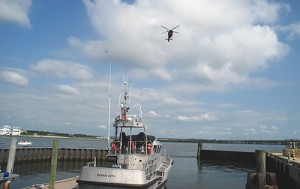
OCEAN CITY — While Ocean City has banned the sale of laser pointers, they continue to create problems for aviation, including Coast Guard helicopter search and rescue missions in the resort area and along the coast.
The crew on a Coast Guard MH-65 Dolphin helicopter landed at Coast Guard Station Ocean City on Tuesday morning to discuss the continuing dangers of novelty laser pointers that became popular in Boardwalk shops and other retail outlets a few years back. While the town of Ocean City, along with other municipalities up and down the east coast, have since banned the sale of lasers, they continue to create public safety issues and problems for aviation, particularly state police and Coast Guard search and rescue and patient transport helicopters.
“Whatever we’re doing, whether it’s training or a critical search and rescue mission, we have to stop and get our people checked out before we can do anything else if the aircraft has been lased,” said Coast Guard Lieutenant Sean Glavan, who piloted the MH-65 Dolphin from Air Station Atlantic City to Ocean City on Tuesday morning. “We can be in a midst of a critical situation and if the aircraft gets lased, we have to stop and follow this entire protocol that can take us off our mission and lose critical time.”
Glavan explained the pointing of a laser at an aircraft, while not often with malicious intent, can cause at the very least a distraction in a critical situation. At worst, it can cause glare, obstructions and flash blindness, which temporarily impairs a Coast Guard helicopter pilot and crew. While Glavan and his crew were relating some of the issues with search and rescue missions, the issue is not unique to the Coast Guard. In recent years, there have been several incidents reported with Maryland State Police helicopters transporting patients in critical condition to Shock Trauma and other hospitals.
“About 70 percent of our missions are carried out at below 2,000 feet, which is well within the range of even a novelty laser pointer,” he said. “We might be in a critical phase of our flight on an approach to a hospital or the landing site for a search and rescue mission, and if we get lased, we have to turn around and go through this entire protocol to make sure none of our crewmembers are debilitated. There is this entire administrative side where we have to file reports with the times and locations of the incident, and a medical side where we have to get all of our people checked out. As you can imagine, all of that takes an enormous amount of time, time that we should be spending on critical missions.”
The MH-65 Dolphin flies with a crew of four, including a pilot, co-pilot, rescue swimmer and flight mechanic. If even one of the crewmembers is compromised by a laser incident, the helicopter must take the appropriate precautions, or even abort a mission in some extreme cases.
“There are four crew members on a search and rescue mission, and each has a critical job to do,” said Coast Guard Flight Mechanic Rob Grossman. “If the aircraft gets lased, we can’t continue without even one of them.”
Lasers became a serious issue in Ocean City in recent years to the point town officials passed emergency ordinances banning their proliferation after several incidents were reported of individuals shining the novelty lasers in people’s eyes and into resident’s windows. In fact, the town of Ocean City was out in front of the laser issue and its original ordinance paved the way for a later statewide ban.
Ocean City in 1998 passed an emergency ordinance banning the harassing or annoying shining of laser pointers on a person and it became a Maryland state law a year after. In 2010, when the popular lasers proliferated again on the Boardwalk in Ocean City, the town passed an ordinance banning their sale to minors and making possession by minors illegal.
In May 2014, the town passed another emergency ordinance banning laser pointers altogether. Nonetheless, they continue to create problems for private citizens, law enforcement and public safety officials and the Coast Guard.
“We know Ocean City banned them, as did Atlantic City and other coastal communities in South Jersey,” said Grossman. “However, they’re still readily available in other retail outlets and online. When a lot of these laws were passed, it was the red lasers that were creating the problem, but the big issue now is the lasers in the green spectrum.”
Glavan said Coast Guard Station Atlantic City, where his MH-65 Dolphin is based, handles around two or three incidents a week involving individuals shining lasers on the aircraft. Coast Guard Air Station Atlantic City’s response area covers a large swath of the mid-Atlantic including Ocean City and as far south as Chincoteague.
“When you compare it to driving, anything that is a distraction can be dangerous,” he said. “Now think about being distracted in a high-tech military aircraft on a critical search and rescue mission.”
